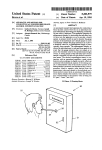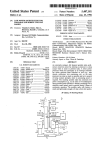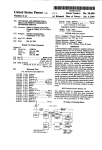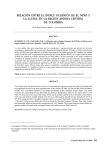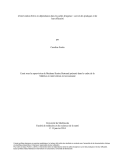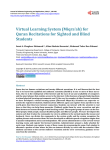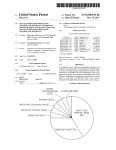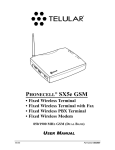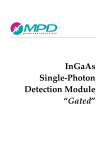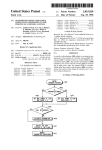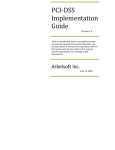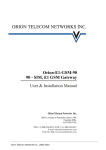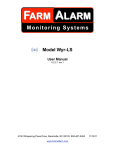Download co (3 a)
Transcript
US005247565A United States Patent [191 [11] Patent Number: Joglekar et a1. [45] [54] CELLULAR TELEPHONE WITH KEYPAD CONTROLLER [75] Inventors: Manohar A. Joglekar, Long Grove; Philip F. Aseltine, Arlington Heights, Date of Patent: 5,247,565 Sep. 21, 1993 OTHER PUBLICATIONS Motorola Instruction Manual N0. lS-SP134682. Motorola Instruction Manual No. 68P81071E30. The Celjack Owners Manual by Telular Inc. “Description and Speci?cation GNTA Payphone Type both of I11. AY4 (NMT) for Connection to a Mobile Radiostation [73] Assignee: Motorola, Inc., Schaumburg, Ill. in Accordancerwith the Speci?cations for the Nordic Mobile Telephone Systems (NMT)”. [21] App]. N0.: 779,787 Primary Examiner-James L. Dwyer [22] Filed: Assistant Examiner-M. Shehata Attorney, Agent, or Firm—Kenneth W. Bolvin [63] Oct. 21, 1991 Related U.S. Application Data Continuation-impart of Ser. No. 622,201, Nov. 27, 1990, Pat. No. 5,117,450, which is a continuation of Ser. No. 369,419, Jun. 20, 1989, abandoned, which is a continuation-in-part of Ser. No. 349,619, May 10, 1989, abandoned. [51] Int. Cl.5 .......................................... “1104M 11/00 [52] U.S. Cl. ...................................... .. 379/58; 379/63; [58] Field of Search ..................... .. 579/58, 59, 60, 61, 7 379/355 579/63, 355, 356 [56] References Cited U.S. PATENT DOCUMENTS 4,658,096 4,718,080 4/1987 1/1988 4,737,975 4,745,632 4,775,997 4,972,459 5,086,452 4/1988 5/1988 10/1988 11/1990 2/1992 5,148,471 5,117,450 West, Jr. ............................. .. 379/59 Serrano etal. ..................... .. 379/59 9/1992 5/1992 Metroka et a1. .................... .. 379/58 541 ' co (3 a) troller (504) for controlling the operating modes thereof and automatically placing and receiving cellular tele phone calls dialed in any pattern. The keypad includes numerical keys (0-9, # and ") and function keys (MEM and END/CLEAR) for entering digits of telephone number and key sequences for selecting operating modes. Power is applied to the cellular telephone trans ceiver (519) in response to concurrent activation of at least two keys. Each telephone number digit is detected and accumulated by microcomputer (508) and, after a pause of four seconds, the accumulated digits are sent via a data bus (511) to cellular telephone transceiver (519) for placing a telephone call. The call is subse quently terminated when the END key is activated or an END command is received by the cellular telephone transceiver (519). Thereafter, power to the cellular telephone transceiver (519) may be turned off in re sponse to activation of the MEM-END key sequence. 15 Claims, 4 Drawing Sheets AUDIO CIRCUIT - E) G) E) cellular telephone transceiver (519), and keypad con , sat-g 3g 8 5> 542 ®®® O [57] ABSTRACT A unique cellular telephone (500) includes audio circuit 502, microcomputer (508), indicators (506) and (507), “500 mcaocowurra WITH RADIO TRANSCEIVER NICROCOMPUTER WITH MEMORY 529 US. Patent Sep. 21, 1993 Sheet 1 of 4 /29:. m52 : ugzoi :52“; mugzoci >zowz :23 :5; 3“n 5,247,565 US. Patent Sep. 21, 1993 Sheet 2 of 4 5,247,565 ‘TURN POWER on mo was emu LED on GENERATE DIAL TONE 608 610 MEN-END YES PREgSED TURN POWER OFF NO on d N 616 MEN-I YES mssco ? NO 6 618 NEH-5 PRESSED ? NO YES U 620 MEI~0 PREgSED YES N0 No DIG" 624 RECALL NUMBER FROM SCRATCH PAD AND 0mm: BEEP 622 Pnsgsco YES a A u , FIG.2A US. Patent Sep. 21, 1993 Sheet 3 of 4 636 s25 STORE men mo RESET 4 sm. TIMER 630 YES N0 4 SR. _ 652 TIMER ngEo our YES N0 ‘ NO 634 NO YES YES RECALL NUMBER FROM LOCATION XX 538 PLACE THE CALL 640 ' 642 NO YES W m US. Patent Sep. 21, 1993 5,247,565 Sheet 4 of 4 LOCK TRANSCEIVER AND FLASH RED LED NO NO YE 5 OENERATE SWITCH HOOK FLASH s 48 7 UNLOCK co?oc UNLOCK TRANSCEIVER AND STOP FLASHING RED LEO 650 Maw 0R N0 MEN-I gncsszn . 6 52 YES ADJUST HANDS FREE VOLUNE UP‘ FIG.2E OR DOWNI . 662 ? NO END FLASH GREEN LED AND GENERATE ONE BEEP 656 YES PRESSED 66,4 NEH-6 No. PRESSED '1’ YES 655 TOP FLASHING CREE LED AND ENERATE TWO BEEPS 6 NO NO END RECEfIVED YES END THE CALL 678 660 FIG.2C 5,247,565 1 2 select a corresponding one of the operating modes, respectively, the predetermined key sequences includ CELLULAR TELEPHONE WITH KEYPAD CONTROLLER ing the memory key and another key, the second mi crocomputer storing each received digit in the memory, and the second microcomputer further being coupled to the ?rst port of the data bus for automatically transmit ' RELATED APPLICATIONS The present invention is a continuation-in-part appli cation based on copending U.S. patent application Ser. No. 07/622,201, ?led Nov. 27, 1990, now US. Pat. No. 5,117,450 issued on May 26, 1992 assigned to the instant ting the stored digits or the selected one of the operat ing modes to the cellular transceiver when the elapsed time from detection of the last activated key exceeds a predetermined time interval; and the ?rst microcom puter coupled to the second port of the data bus for receiving the transmitted one of the operating modes and applying the received operating mode to the cellu assignee, and incorporated herein by reference. US. patent application Ser. No. 07/622,201 is a continuation based on the instant assignee’s US. patent application Ser. No. 07/369,419, ?led Jun. 20, 1989 and now aban doned, which in turn is a continuation-in-part applica tion based on the instant assignee’s US. patent applica tion Ser. No. 07/349,619, ?led May 10, 1989 and now lar transceiver, and receiving the transmitted digits and automatically transmitting the received digits on one of the cellular radio channels to originate a telephone call, whereby all dialed digits of each telephone number are abandoned. automatically transmitted when dialing is interrupted BACKGROUND OF THE INVENTION for at least the predetermined time interval. The present invention is generally related to radio 20 BRIEF DESCRIPTION OF THE DRAWINGS telephones, and more particularly to a cellular tele phone with a keypad controller. FIG. 1 is a block diagram of another cellular tele Cellular telephones currently are operated with a phone 500 embodying the present invention, into which special purpose handset having an integrated display, a keypad controller 504' may be plugged. keypad, microphone and speaker, that is coupled via 25 audio and data buses to a cellular telephone transceiver. Such special purpose handsets may not be miniaturized FIG. 2, comprised of FIGS. 2A, 2B, 2C, 2D and 2E, is a flow chart for the process used by microcomputer 508 in FIG. 1 for control and operation of cellular tele phone 500 in response to the MEM key, END/CLEAR due to the integrated display, keypad, microphone and speaker, and their associated control circuitry. In order to avoid use of a cellular radio channel during dialing 30 and minimize costs of cellular telephone calls, cellular key, and digit keys of controller 504. FIG. 3 is a ?ow chart for the process used by mi crocomputer 508 in FIG. 1 for processing incoming telephone users are required to dial a telephone number telephone calls. and then press a “SEND” button (pre-origination dial ing), in order to place a cellular telephone call. Pressing DESCRIPTION OF THE PREFERRED the “SEND” button causes the cellular telephone hand 35 EMBODIMENT set to generate a “SEND” signal and append it to the Referring to FIG. 1, there is illustrated a block dia dialed digits transmitted to the cellular telephone trans ceiver. In contrast, conventional landline telephones place telephone calls automatically after a pause in dial ing of several seconds. Such special purpose handsets also provide many different user features requiring complex software and additional circuitry. Thus, such 40 gram of another cellular telephone 500 embodying the present invention, into which a keypad controller 504 may be plugged. Cellular telephone 500 includes audio circuit 502, microcomputer 508, indicators 506 and 507, and cellular telephone transceiver 509. Note, however, special purpose handsets are both relatively large due to that cellular telephone 500 does not include an informa ity of keys including ten numerical keys for entering MEM and END/CLEAR in controller 504, as well as tion display as is typical of conventional cellular tele the integrated keypad, display, microphone and speaker, and relatively expensive due to the complex 45 phones, such as the cellular telephone. By utilizing the present invention, the need for an information display software and additional circuitry therein. Moreover, has been eliminated since cellular telephone 500 may be such special purpose handset does not operate like con operated and controlled solely by utilizing controller ventional landline telephones. For the foregoing rea 504 and its numerical keys 0-9, # and ' and function sons, there is a need for a cellular telephone with an inexpensive keypad controller which does not include a 50 keys MEM and END/CLEAR. Audio circuit 502 of cellular telephone 500 couples “SEND” button and integrated display. speaker 544 to the radio receiver of, and microphone SUMMARY OF THE INVENTION 545 to the radio transmitter of, radio transceiver 519. Microphone 545 is preferably disposed behind grill-type The present invention encompasses cellular tele openings 543 in controller 504. Speaker S44 is not dis 55 phone apparatus having a plurality of operating modes posed in controller 504. Since controller 504 does not and being operable on cellular radio channels, the cellu include a display or speaker 544, controller 504 is lar telephone apparatus comprising: a data bus having smaller and less‘ complex than prior art telephone-type ?rst and second ports; a cellular transceiver including a handsets. ?rst microcomputer for controlling the operating Microcomputer 508 of cellular telephone 500 is cou modes and communicating cellular telephone calls on pled to numerical keys 0-9, # and * and to function keys the cellular radio channels; a controller having a plural to LED indicators 506 and 507 and their corresponding resistors 532 and 533. LED indicator 506 is lit in white controlling the operating modes of the radiotelephone; a second microcomputer including a memory and cou 65 color to indicate that cellular telephone 500 is in a ROAM operating mode, and LED indicator 507 is lit in pled to the controller for detecting activations of indiv red color to indicate that cellular telephone 500 is in the dual keys to receive telephone number digits and con NO SERVICE operating mode or is lit in green color current activations of predetermined key sequences to telephone numbers and including a memory key for 3 5,247,565 to indicate that cellular telephone 500 is in the POWER ON and HOME operating modes. LED indicator 506 is 4 response to concurrent activation of any two keys. Next, at block 608, a dial tone is generated by mi crocomputer 508 and applied to speaker 544. preferably positioned in opening 542 in controller 504, and LED indicator 507 is preferably positioned in open ing 541 in controller 504. Proceeding to decision block 610 in FIG. 2A, a check is made to determine if a MEM-END key sequence has been pressed. If so, YES branch is taken to block 612, Cellular telephone transceiver 509 includes a radio transceiver 519 and microcomputer 529 with memory where microcomputer 508 turns power off, and thereaf therein for controlling the operation thereof. Cellular ter program control returns to other tasks at block 614. According to a feature of the present invention, power telephone transceiver 509 may be any conventional cellular telephone transceiver having a radio transmit ter, radio receiver and logic unit, such as, for example, the conventional transceiver shown and described in Motorola instruction manual number 68P81066E40, entitled “DYNATAC Cellular Mobile Telephone 800 is turned on in response to concurrent activation of the MEM-END key sequence. If a MEM~END key se quence has not been pressed, N0 branch is taken from decision block 610 to decision block 616, where a check is made to determine if a MEM-# key sequence has MHZ Transceiver,” published by and available from Motorola C & E Parts, 1313 East Algonquin Road, Schaumburg, Ill. 60196. The operating modes of such been pressed. According to a feature of the present invention, the telephone-number store mode is entered in response to concurrent activation of the MEM-# key conventional transceiver are described in Motorola sequence. If the MEM-# key sequence has been pressed, YES branch is taken from decision block 616 to user’s manual number 68P8lll6E58, entitled “DYNA TAC 6800XL Cellular Mobile Telephone USER’S 20 exit point G to FIG. 2D, where, at block 668, mi crocomputer 508 receives each activated key as digits MANUAL,” published by and available from Motorola of a telephone number. Next, at decision block 670 in C & E Parts, 1313 East Algonquin Road, Schaumburg, FIG. 2D, a chick is made to determine if a MEM Ill. 60196. MEM-XX key sequence has been pressed, where XX In the preferred embodiment, microcomputer 529 of cellular telephone transceiver 509 is coupled to mi 25 represents two numerical keys 0-9. If not, NO branch is taken back to block 668 to receive another digit. If a crocomputer 508 by way of a three~wire data bus 511, MEM-MEM-XX key sequence has been pressed, YES which is illustrated and described in US. Pat. No. branch is taken from decision block 670 to block 672, 4,369,516. Microcomputer 508 continuously looks for where the previously received digits are stored as a activated numerical and functions keys of controller 504. Each telephone number digit corresponding to an 30 telephone number in the memory of microcomputer 508 at location XX. Thereafter program control exits at activated numerical key is detected and accumulated by microcomputer 508 in its memory. After a pause of four seconds, the accumulated digits are coded as described in the aforementioned US. Pat. No. 4,369,516 and trans mitted by microcomputer 508 together with a SEND point B to return to block 608 and continue as described hereinabove. - Returning to decision block 616 in FIG. 2A, if a 35 MEM-# key sequence has not been pressed, NO branch command via bus 511 to microcomputer 529. Mi crocomputer 529 receives the dialed digits from bus 511 and encodes and transmits them via the cellular radio channels by means of the radio transmitter of radio transceiver 519 for placing a cellular telephone call. Key sequences of two or more concurrently acti vated function keys and/or numerical keys are also where, at block 674, microcomputer 508 electronically locks cellular telephone transceiver 509 and ?ashes red detected by microcomputer 508 for selecting operating telephone transceiver 509 is electronically locked in is taken to decision block 618, where a check is made to determine if a MEM-5 key sequence has been pressed. If so, YES branch is is taken to exit point H to FIG. 2E, LED indicator 506. According to a feature of the pres ent invention, the lock mode is entered where cellular response to concurrent activation of the MEM-5 key modes of cellular telephone 500. The detected key se quences are coded into corresponding commands and 45 sequence. Next, at decision block 676 in FIG. 2E, a check is made to determine if a three-key unlock se transmitted via bus 511 to microcomputer 529. The operating modes of cellular telephone 500 include the quence has been pressed. If not, NO branch is taken back to block 674 to continue ?ashing red LED indica power-on mode, power~off mode, telephone-number tor 506. If the proper three-key unlock sequence has re-dial mode, telephone-number re-call mode, tele been pressed, YES branch is taken to block 678, where phone-number store mode, lock mode, DTMF mode, hookswitch-?ash mode, speaker-volume adjust mode, and call-privacy mode. Referring next to FIG. 2, comprised of FIGS. 2A, 2B, 2C, 2D and 2E, there is illustrated a ?ow chart for the process used by microcomputer 508 in FIG. 1 for control and operation of cellular telephone 500 in re sponse to the MEM key, END/CLEAR key, and nu merical keys of controller 504. Entering at START block 602 in FIG. 2A, the process proceeds to decision block 604, where a check is made to determine if any two keys of controller 504 have been pressed. If not, NO branch is taken to wait. If two keys of controller 504 have been pressed, YES branch is taken from deci sion block 604 to block 606, where microcomputer 508 microcomputer 508 electronically unlocks cellular tele phone transceiver 509 and stops ?ashing red LED indi cator 506. Thereafter program control exits at point B to return to block 608 and continue as described herein above. Returning to decision block 618 in FIG. 2A, if a MEM-5 key sequence has not been pressed, N0 branch is taken to decision block 620, where a check is made to determine if a MEM-0 key sequence has been pressed. If so, YES branch is taken to block 622, microcomputer 508 recalls the last dialed telephone number from the scratch pad location in its memory and generates a beep in speaker 544 to advise the user. According to a feature of the present invention, the telephone number re-dial turns power on to cellular transceiver 519 and lights the 65 mode is entered where the last dialed telephone number is re-dialed in response to concurrent activation of the green LED indicator 507. According to a feature of the present invention, the power-on mode is entered where MEM-0 key sequence. Thereafter program control exits the power is turned on to cellular transceiver 519 in at point B to proceed to block 640 and continue as 5,247,565 5 described hereinbelow. If a MEM-O key sequence has not been pressed, NO branch is taken from decision block 620 to decision block 624, where a check is made to determine if a numerical key has been pressed. If not, NO branch is taken to decision block 610 to repeat the foregoing process. If a numerical key has been pressed, YES branch is is taken from decision block 624 in FIG. 2A to exit point C to FIG. 2B, where, at block 626, microcomputer 508 stores the digit associated with the activated key in its 6 determine if a .MEM-MEM key sequence has been pressed. If so, YES branch is taken to block 648, where microcomputer 508 generates a hook switch ?ash. Ac cording to a feature of the present invention, the hook switch-?ash mode is entered where a hookswitch ?ash is generated in response to concurrent activation of the MEM-MEM key sequence during a call. From block 648 and NO branch of decision block 646, program control proceeds to decision block 650, where a check memory and resets a four second timer. Next, at deci is made to determine if a MEM-* or a MEM-# key sequence has been pressed. If so, YES branch is taken to sion block 626 in FIG. 2B, a check is made to determine block 652, where microcomputer 508 changes the vol if another numerical key has been pressed. If so, YES ume of speaker 544 up a predetermined amount for MEM-‘ key sequence or down predetermined amount for a MEM-# key sequence. According to a feature of branch is taken back to block 626 to store the associated digit in the memory of microcomputer 508 and reset the timer. If another numerical key has not been pressed, NO branch is taken from decision block 630 to decision the present invention, the speaker-volume adjust mode is entered where the volume of speaker 544 is adjusted up or down in response to concurrent activation of the block 632, where a check is made to determine if four MEM-* or MEM-# key sequence, respectively, during second timer has timed out. If not, NO branch is taken to decision block 634, where a check is made to deter 20 a call. From block 652 and NO branch of decision block 650 mine if the END key has been pressed. If so, YES in FIG. 2C, program control proceeds to decision block branch is taken to exit at point B to return to block 608 654, where a check is made to determine if a MEM-6 and continue as described hereinabove. If the END key has not been pressed, NO branch is taken from decision key sequence has been pressed. If so, YES branch is block 634 back to decision block 630 to continue as 25 taken back to block 662, where microcomputer 508 described hereinabove. ~ ' In other embodiments, rather than store each digit at block 626, microcomputer 508 may instead code each digit immediately after detection and transmit the coded digit via bus 511 to microcomputer 529, where the re 30 ?ashes the green LED indicator 507, mutes the micro phone audio, and generates a beep in speaker 544 to advise the user. According to a feature of the present ceived digits may be accumulated and automatically invention, the call-privacy mode is enteredlwhere audio from microphone 545 is muted for privacy in response to concurrent activation of the MEM-6 key sequence transmitted on the cellular radio channels four seconds during a call. Next, at decision block 664 in FIG. 2C, a check is made to determine if a MEM-6 key sequence after receipt of the last digit. This operation is illustrated has been pressed again. If not, NO branch is taken to and described in the instant assignee’s aforementioned U.S. patent application Ser. No. 07/622,201, ?led Nov. 35 wait. If a MEM-6 key sequence has been pressed again, YES branch is taken to block 666, where where mi 27, 1990. crocomputer 508 stops ?ashing the green LED indica Returning to decision block 632 in FIG. 2B, if the tor 507, unmutes the microphone audio, and generates four second timer has timed out, YES branch is taken to two beeps in speaker 544 to advise the user. From block 666 and NO branch of decision block 654 in FIG. 2C, program control proceeds to decision block 656, where a check is made to determine if the END key has been pressed. If not, NO branch is taken to decision block 658, where a check is made to determine advise the user. According to a feature of the present 45 if an END command has been received by cellular telephone transceiver 509. If not, NO branch is taken to invention, the telephone-number re-call mode is entered exits at point F to return to decision block 642 and where one or two-digit numbers cause telephone num continue as described hereinabove. If the END key has bers stored at locations l-99 to be speed dialed. Next, at been pressed or if an END command has been received block 640, microcomputer508 places a telephone call to the dialed or recalled telephone number. At this point, 50 by cellular telephone transceiver 509, YES branch is taken from decision blocks 656 or 658, respectively, to the telephone number digits accumulated in the mem block 660 to end the current call. Thereafter, program ory of microcomputer 508 or the recalled digits are control exits at point B to return to block 608 and con coded and transmitted together with a SEND code by tinue as described hereinabove. microcomputer 508 via bus 511 to microcomputer 529, Referring next to FIG. 3, there is illustrated a ?ow where they are encoded and transmitted via the cellular 55 chart for the process used by microcomputer 508 in radio channels by means of the radio transmitterof decision block 636, where a check is made to determine if only one or two digits have been dialed (except for “zero” which accesses the operator). If so, YES branch is is taken to block 638, where microcomputer 508 re calls the telephone number from the location X or XX in its memory and generates a beep in speaker 544 to radio transceiver 519 for placing a cellular telephone FIG. 1 for processing incoming telephone calls. Enter call. Then, at decision block 642, a check is made to ing at START block 702, the process proceeds to deci determine if another digit has been dialed. If so, YES branch is is taken to block 644, where microcomputer 508 generates the DTMF tone corresponding to the dialed digit. According to the feature of the present invention, the DTMF mode is entered where DTMF tones are generated in response to each digit dialed incoming call has been received. If not, NO branch is taken to wait. If an incoming call has been received, YES branch is taken from decision block 704 to block 706, where microcomputer 508 generates a an elec sion block 704, where a check is made to determine if an tronic ringing signal 116 which is applied to speaker 65 544. Next, at decision block 708, a check of the keys of during a call. controller 504 is made to determine if any key has been From block 644 and NO branch of decision block 642 pressed. If not, NO branch is taken to wait. According in FIG. 2B, program control exits at point D to FIG. to a feature of the present invention, an incoming call is 2C, where, at decision block 646, a check is made to 7 5,247,565 answered in response to activation of any key. If a key of controller 504 has been pressed, YES branch is taken from decision block 708 to block 710 to connect the call and thereafter proceed to entry point F in FIG. 2B to continue as described hereinabove. In summary, a unique cellular telephone includes a keypad controller-for controlling the operating modes thereof and automatically placing and receiving cellular telephone calls dialed in any pattern. The novel keypad controller includes numerical keys 0-9, # and "’ and function keys MEM and END/CLEAR, and does not require an information display as in prior art cellular telephone handsets. The dialed digits of a telephone number are stored and automatically transmitted in response to a four second pause by the unique cellular telephone of the present invention for placement of a cellular telephone call without using a “SEND” button. We claim: 1. Cellular telephone apparatus having a plurality of operating modes and being operable on cellular radio 20 channels, and cellular telephone apparatus comprising: a data bus having ?rst and second ports; a transceiver including a ?rst microcomputer for controlling the operating modes and communicat ing cellular telephone calls on the cellular radio channels; a controller having a plurality of keys including ten numerical keys for entering telephone numbers and including a memory key for controlling the operat ing modes of the cellular telephone apparatus; a second microcomputer including a memory and being coupled to the controller for detecting acti vations of individual keys to receive telephone number digits and for detecting concurrent activa 8 end key and said second microcomputer is responsive to concurrent activation of the memory key and the end key for removing power from said cellular transceiver. 6. Cellular telephone apparatus having a plurality of operating modes, said cellular telephone apparatus com prising: a data bus having ?rst and second ports; a cellular transceiver including a ?rst microcomputer and being operable on the cellular radio channels for communicating cellular telephone calls; a controller having a plurality of keys including ten numerical keys for entering telephone numbers and including a memory key for controlling the operat ing modes of the cellular telephone apparatus; a second microcomputer including a memory and being coupled to the controller for detecting acti vations of individual keys to receive telephone number digits and for detecting concurrent activa tions of predetermined key sequences to select a corresponding one of the operating modes, the predetermined key sequences including the mem ory key and another key, said second microcom puter validating and storing each received digit in the memory, and said second microcomputer fur ther being coupled to the ?rst port of said data bus for automatically transmitting the stored digits or the selected one of the operating modes to the cellular transceiver when the elapsed time from detection of the last activated key exceeds a prede termined time interval; and said ?rst microcomputer coupled to the second port of said data bus for receiving the selected one of the operating modes and applying the received operat ing mode to the cellular transceiver, and receiving the transmitted digits and automatically transmit tions of predetermined key sequences to select a 35 ting the received digits on one of the cellular radio corresponding one of the operating modes, the channels to originate a telephone call, whereby all predetermined key sequences including the mem ory key and another key, said second microcom dialed digits of each telephone number are auto matically transmitted when dialing is interrupted puter storing each received digit in the memory, and said second microcomputer further being cou for at least the predetermined time interval. ‘7. The cellular telephone apparatus according to pled to the ?rst port of said data bus for automati cally transmitting the stored digits or the selected claim 6, wherein said second microcomputer is respon sive for concurrent activation of any two keys for ap ceiver when the elapsed time from detection of the plying power to said cellular transceiver. last activated key exceeds a predetermined time 45 8. The cellular telephone apparatus according to claim 7, wherein said cellular telephone further includes interval; and said ?rst microcomputer coupled to the second port an indicator coupled to the second microcomputer for of said data bus for receiving the selected one of the providing a visual indication when power is on. operating modes and applying the received operat 9. The - cellular telephone apparatus according to claim 8, wherein said indicator is a light emitting diode. ing mode to the cellular transceiver, and receiving the transmitted digits and automatically transmit 10. The cellular telephone apparatus according to ting the received digits on one of the cellular radio claim 7, wherein said controller further includes an end channels to originate a telephone call, whereby all key and said second microcomputer is responsive to dialed digits of each telephone number are auto concurrent activation of the memory key and the end matically transmitted when dialing is interrupted key for removing power from said cellular transceiver. for at least the predetermined time interval. 11. A method of operating a radiotelephone having a 2. The cellular telephone apparatus according to plurality of operating modes, the radiotelephone includ claim 1, wherein said second microcomputer is respon ing a controller coupled by a microcomputer with a sive for concurrent activation of any two keys for ap memory to a cellular transceiver, the cellular trans-' plying power to said cellular transceiver. ceiver being operable on cellular radio channels for 3. The cellular telephone apparatus according to communicating cellular telephone calls, and the con troller including ten numerical keys for entering tele claim 2, wherein said cellular telephone further includes an indicator coupled to the second microcomputer for phone numbers and including a memory key and an end one of the operating modes to the cellular trans providing a visual indication when power is on. 4. The cellular telephone apparatus according to claim 3, wherein said indicator is a light emitting diode. 5. The cellular telephone apparatus according to claim 2, wherein said controller further includes and key for controlling the operating modes of the radio telephone, said method comprising the steps of: detecting concurrent activation of at least two keys to select a power-on mode and applying power to said cellular transceiver; 5,247,565 10 13. The method according to claim 12, further includ ing the step of detecting concurrent activation of the memory and the end key to select a power-down mode, detecting activations of individual keys and concur rent activations of predetermined key sequences to receive telephone number digits and to select a corresponding one of the operating modes, respec said method including the step of removing power from said cellular transceiver when the power-down mode is tively, the predetermined key sequences including selected. 14. The method according to claim 11, wherein the the memory key and another key; storing each received telephone number digit in the predetermined key sequences include a memory key followed by a ?rst predetermined numerical key for selecting a re-dial mode, said method further including the step of re-transmitting the previously transmitted memory; automatically transmitting all of the stored telephone number digits on one of the cellular radio channels telephone number digits when the re-dial mode is se when the elapsed time from detection of the last lected. activated key exceeds a predetermined time inter 15. The method according to claim 11, wherein the val to originate a telephone call; and 15 predetermined key sequences include a memory key ending a telephone call when activation of the end followed by a second predetermined numerical key for key is detected. ‘ selecting the lock mode, said method further including 12. The method according to claim 11, further includ the step of electronically locking the cellular trans ing the step of enabling an indicator during the power ceiver when the lock mode is selected. on mode. 20 25 35 45 55 65 i i i i i










